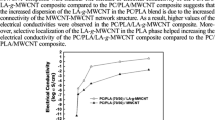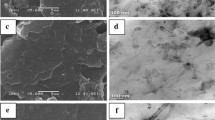Abstract
The effects of multi-walled carbon nanotubes (MWCNTs) with different functional groups on the properties of the polycarbonate (PC)/poly (lactic acid) (PLA) was investigated. Non-functionalized (MWCNT), hydroxyl-functionalized (MWCNT-OH), carboxyl-functionalized (MWCNT-COOH), and polycarbonate-grafted multi-walled carbon nanotube (PC-g-MWCNT) were selected as nano-additives for PC/PLA. PC-g-MWCNT were prepared by reacting between the hydroxyl groups on MWCNT-OH and the carbonyl groups in PC by the reactive extrusion. Fourier transformed infrared spectroscopy (FTIR) analysis was performed to support the functionalization process and determined the chemical structure of the modified nanotube. MWCNTs were compounded with PC/PLA in a twin-screw micro compounder and moulded with the laboratory-scale injection moulding machine. Nano-additives was added to the polymer matrix at 3–5 wt.% loading levels. Characterization of the prepared samples was realized by the thermal, mechanical, electrical conductivity, and morphological analysis. As a result of FTIR analysis, nanotubes were seen to bind successfully to the PC. The best effect at onset decomposition temperatures was achieved by increasing about 39.8 °C with the addition of 5 wt.% MWCNT-OH to the PC/PLA. The highest elongation at break, tensile strength, and modulus was obtained for nanocomposites containing MWCNT-COOH. The selective localization of PC-g-MWCNT in the matrix provided the highest electrical conductivity in 5 wt.% PC-g-MWCNT added nanocomposite.









Similar content being viewed by others
References
Kietzke T, Neher D, Landfester K et al (2003) Novel approaches to polymer belnds based on polymer nanoparticles. Nat Mater 2:408–416. https://doi.org/10.1038/nmat889
Ayandele E, Sarkar B, Alexandridis P (2012) Polyhedral oligomeric silsesquioxane (POSS)-containing polymer nanocomposites. Nanomaterials 2:445–475. https://doi.org/10.3390/nano2040445
Pötschke P, Fornes TD, Paul DR (2002) Rheological behavior of multiwalled carbon nanotube / polycarbonate composites. Polymer (Guildf) 43:3247–3255
Pötschke P, Abdel-Goad M, Alig I et al (2004) Rheological and dielectrical characterization of melt mixed polycarbonate-multiwalled carbon nanotube composites. Polymer (Guildf) 45:8863–8870. https://doi.org/10.1016/j.polymer.2004.10.040
Qian J, Pu JH, Zha XJ et al (2019) Effect of aspect ratio of multi-wall carbon nanotubes on the dispersion in ethylene-α-octene block copolymer and the properties of the Nanocomposites. J Polym Res 26:1–11. https://doi.org/10.1007/s10965-019-1915-1
Samuel J, Dikshit A, DeVor RE et al (2009) Effect of carbon nanotube (CNT) loading on the thermomechanical properties and the machinability of CNT-reinforced polymer composites. J Manuf Sci Eng Trans ASME 131:0310081–0310089. https://doi.org/10.1115/1.3123337
Kapoor S, Sharma V, Goyal M, Jindal P (2020) Effect of carboxylic multi-walled carbon nanotubes on mechanical properties of Acrylonitrile Butadiene Styrene nanocomposite. Mater Today Proc 28:1739–1743. https://doi.org/10.1016/j.matpr.2020.05.154
Sung YT, Kum CK, Lee HS et al (2005) Dynamic mechanical and morphological properties of polycarbonate/multi- walled carbon nanotube composites. Polymer (Guildf) 46:5656–5661. https://doi.org/10.1016/j.polymer.2005.04.075
Sung YT, Han MS, Song KH et al (2006) Rheological and electrical properties of polycarbonate/multi-walled carbon nanotube composites. Polymer (Guildf) 47:4434–4439. https://doi.org/10.1016/j.polymer.2006.04.008
Pérez JM, Vilas JL, Laza JM et al (2010) Effect of reprocessing and accelerated ageing on thermal and mechanical polycarbonate properties. J Mater Process Technol 210:727–733. https://doi.org/10.1016/j.jmatprotec.2009.12.009
Li le J, Wang X, Yang C, Jin F et al (2016) Toughening modification of polycarbonate/poly(butylene terephthalate) blends achieved by simultaneous addition of elastomer particles and carbon nanotubes. Compos Part A Appl Sci Manuf 90:200–210. https://doi.org/10.1016/j.compositesa.2016.07.006
Hassan T, Salam A, Khan A et al (2021) Functional nanocomposites and their potential applications: A review J Polym Res 28 https://doi.org/10.1007/s10965-021-02408-1
Lim LT, Auras R, Rubino M (2008) Processing technologies for poly(lactic acid). Prog Polym Sci 33:820–852. https://doi.org/10.1016/j.progpolymsci.2008.05.004
Nofar M, Sacligil D, Carreau PJ et al (2018) Poly (lactic acid) blends: Processing, properties and applications. Int J Biol Macromol 125:307–360. https://doi.org/10.1016/j.ijbiomac.2018.12.002
Karsli NG, Aytac A (2014) Properties of alkali treated Short flax fiber reinforced poly ( Lactic Acid )/ polycarbonate composites. Fibers Polym 15:2607–2612. https://doi.org/10.1007/s12221-014-2607-4
Wang Y, Chiao SM, Hung T-F, Yang S-Y (2012) Improvement in toughness and heat resistance of poly(lactic acid)/polycarbonate blend through twin-screw blending: Influence of compatibilizer type. J Appl Polym Sci 125:402–412. https://doi.org/10.1002/app.36920
Poothanari MA, Xavier P, Bose S et al (2019) Compatibilising action of multiwalled carbon nanotubes in polycarbonate/polypropylene (PC/PP) blends: phase morphology, viscoelastic phase separation, rheology and percolation. J Polym Res 26:1–15. https://doi.org/10.1007/s10965-019-1833-2
Taraghi I, Fereidoon A, Paszkiewicz S, Roslaniec Z (2018) Nanocomposites based on polymer blends: enhanced interfacial interactions in polycarbonate/ethylene-propylene copolymer blends with multi-walled carbon nanotubes. Compos Interfaces 25:275–286. https://doi.org/10.1080/09276440.2018.1393253
Wang Y-H, Xu X-L, Dai J et al (2014) Super toughened immiscible polycarbonate/ poly(L-lactide) blend achieved by simultaneous addition of compatibilizer and carbon nanotubes. RSC Adv 4:59194–59203. https://doi.org/10.1039/c4ra11282b
Han IS, Lee YK, Lee HS et al (2014) Effects of multi-walled carbon nanotube (MWCNT) dispersion and compatibilizer on the electrical and rheological properties of polycarbonate/poly(acrylonitrile-butadiene-styrene)/MWCNT composites. J Mater Sci 49:4522–4529. https://doi.org/10.1007/s10853-014-8152-0
Mohamed MG, Kuo SW (2019) Functional Silica and Carbon Nanocomposites Based on Polybenzoxazines. Macromol Chem Phys 220:1–13. https://doi.org/10.1002/macp.201800306
Wu D, Wu L, Zhang M, Zhao Y (2008) Viscoelasticity and thermal stability of polylactide composites with various functionalized carbon nanotubes. Polym Degrad Stab 93:1577–1584. https://doi.org/10.1016/j.polymdegradstab.2008.05.001
Rostami A, Nazockdast H, Karimi M (2016) Graphene Induced Microstructural Changes of PLA/MWCNTs Biodegradable Nanocomposites: Rheological, Morphological, Thermal and Electrical Properties. RSC Adv 6:49747–49759. https://doi.org/10.1039/C6RA08345E
Ma PC, Siddiqui NA, Marom G, Kim JK (2010) Dispersion and Functionalization of Carbon Nanotubes for Polymer-Based Nanocomposites: A Review. Compos Part A Appl Sci Manuf 41:1345–1367. https://doi.org/10.1016/j.compositesa.2010.07.003
Babal AS, Gupta R, Singh BP, Dhakate SR (2015) Depression in glass transition temperature of multiwalled carbon nanotubes reinforced polycarbonate composites: Effect of functionalization. RSC Adv 5:43462–43472. https://doi.org/10.1039/c5ra05825b
Jang MG, Lee YK, Kim WN (2015) Influence of lactic acid-grafted multi-walled carbon nanotube ( LA- g -MWCNT ) on the electrical and rheological properties of polycarbonate / Poly ( lactic acid )/ LA- g -MWCNT composites. Macromol Res 23:916–923. https://doi.org/10.1007/s13233-015-3129-7
Choi EY, Kim JY, Kim CK (2015) Fabrication and properties of polycarbonate composites with polycarbonate grafted multi-walled carbon nanotubes by reactive extrusion. Polymer (Guildf) 60:18–25. https://doi.org/10.1016/j.polymer.2015.01.031
Hazer S, Coban M, Aytac A (2018) A Study on Carbon Fiber Reinforced Poly(lactic acid)/Polycarbonate Composites. J Appl Polym Sci 135:1–9. https://doi.org/10.1002/app.46881
Ozkazanc E, Zor S, Ozkazanc H (2016) Structural and dielectric properties of CuCl2 and ZnCl2 doped polyaniline. Polym Compos 37:915–924. https://doi.org/https://doi.org/10.1002/pc.20979
Harris AM, Lee EC (2013) Durability of polylactide-based polymer blends for injection-molded applications. J Appl Polym Sci 128:2136–2144. https://doi.org/10.1002/app.38407
Wang L, Qiu J, Sakai E (2017) Thermal behavior and mechanical properties of nanocomposites of polycarbonate reinforced with multiwalled carbon nanotubes Polym Compos 38:303-313. https://doi.org/10.1002/pc.compositesa.2015.12.016
Wang L, Qiu J, Sakai E, Wei X (2015) The Relationship between microstructure and mechanical properties of carbon nanotubes / polylactic acid nanocomposites prepared by twin-screw extrusion Compos Part A 89:19-25. https://doi.org/10.1016/j.compositesa.2015.12.016
Yoon JT, Jeong YG, Lee SC, Min BG (2009) Influences of poly ( lactic acid ) -grafted carbon nanotube on thermal, mechanical, and electrical properties of poly ( lactic acid ). Polym Adv Techonologies 20:631–638. https://doi.org/10.1002/pat.1312
Raja M, Ryu SH, Shanmugharaj AM (2013) Thermal, mechanical and electroactive shape memory properties of polyurethane (PU)/poly (lactic acid) (PLA)/CNT nanocomposites. Eur Polym J 49:3492–3500
Kim KH, Jo WH (2008) A Strategy for Enhancement of Mechanical and Electrical Properties of Polycarbonate / Multi-Walled Carbon Nanotube Composites. Carbon N Y 47:1126–1134. https://doi.org/10.1016/j.carbon.2008.12.043
Babal A, Gupta R, Singh VN et al (2014) Mechanical and Electrical Properties of High Performance MWCNT/Polycarbonate Composites Prepared by Industrial Viable Twin Screw Extruder with Back Flow Channel. RSC Adv 4:64649–64658. https://doi.org/10.1039/C4RA11319E
Maiti S, Suin S, Shrivastava NK, Khatua BB (2014) Low percolation threshold and high electrical conductivity in melt-blended polycarbonate/multiwall carbon nanotube nanocomposites in the presence of poly(ε-caprolactone). Polym Eng Sci 54:646–659. https://doi.org/10.1002/pen.23600
Pötschke P, Liebscher M, Gärtner T et al (2014) Influence of the MWCNT Surface Functionalization on the Thermoelectric Properties of Melt-Mixed Polycarbonate Composites. Compos Sci Technol 101:133–138. https://doi.org/10.1016/j.compscitech.2014.07.009
Mohamed MG, Lin RC, Kuo SW (2017) Polybenzoxazine/Carbon Nanotube Composites. Elsevier Inc
Chen Y, Peng Y, Liu WY et al (2013) Effect of POSS on the compatibility and mechanical properties of PC/PLA blends Appl Mech Mater 427–429. https://doi.org/10.4028/www.scientific.net/AMM.427-429.170
Maiti S, Suin S, Shrivastava NK, Khatua BB (2013) Low percolation threshold in polycarbonate/multiwalled carbon nanotubes nanocomposites through melt blending with poly(butylene terephthalate). J Appl Polym Sci 130:543–553. https://doi.org/10.1002/app.39168
Acknowledgement
This study was supported by the Scientific Research Center of Kocaeli University. (KOU-BAP) (Project No: 2018/090 and 2019/038).
Author information
Authors and Affiliations
Corresponding author
Additional information
Publisher's Note
Springer Nature remains neutral with regard to jurisdictional claims in published maps and institutional affiliations.
Rights and permissions
About this article
Cite this article
Urtekin, G., Aytac, A. The effects of multi-walled carbon nanotube additives with different functionalities on the properties of polycarbonate/poly (lactic acid) blend. J Polym Res 28, 180 (2021). https://doi.org/10.1007/s10965-021-02539-5
Received:
Accepted:
Published:
DOI: https://doi.org/10.1007/s10965-021-02539-5




